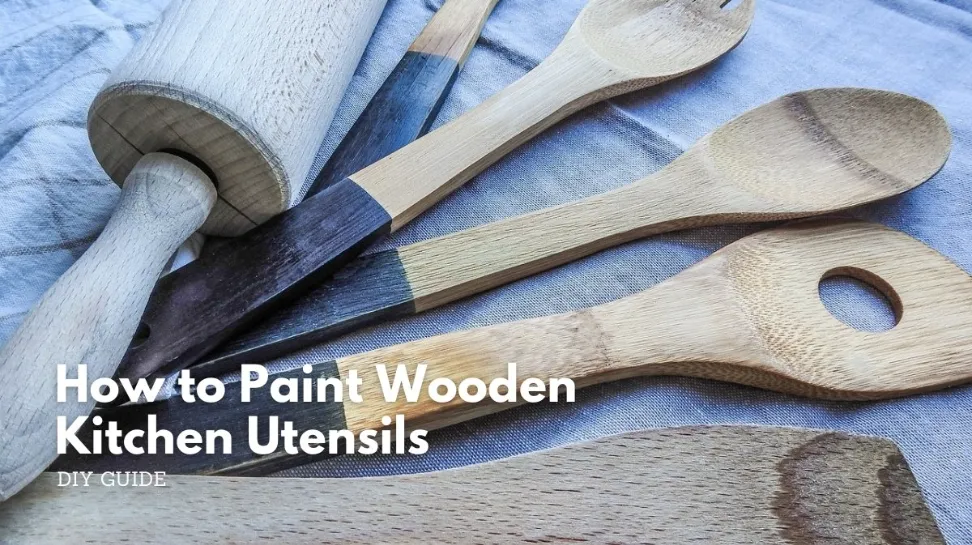How to Paint Wooden Kitchen Utensils
We’ve all been there – rummaging through our drawers to find a wooden spoon with no chips or stains seems impossible. But it doesn’t have to be that way. A fresh layer of non-toxic enamel paint is all it takes to breathe new life into those weary utensils and protect their surfaces from future wear and tear. No more tossing chipped utensils – you’ll be able to reuse them for years to come.
Painting your wooden kitchen utensils isn’t just about aesthetics either. Did you know that different colored utensils can help you stay organized? Imagine never again scrambling to find the right spoon for your latest recipe thanks to its bright hue, Or never mixing up herbs and spices because each has its own identifying shade.
Best of all, transforming your dull wooden spoons, spatulas, and the like into pops of color is easier than you think. Well, I’ve saved you the agony of Googling around for tips – in this article, I will spill all my painting secrets to help you make your tired wooden utensils shine again.
Table of Contents
10 Simple Steps to Paint Your Wooden Kitchen Utensils
Tools You’ll Need
- Wooden Kitchen Utensils
- Newspapers or Drop Cloth
- Warm Soapy Water
- Fine-Grit Sandpaper
- Damp Cloth
- Food-Safe Primer
- Food-Safe, Non-Toxic Acrylic Paint
- Paint Brushes
- Painter’s Tape
- Food-Safe Sealant
Step 1: Choose Your Utensils
The type of wood your utensils are made of will greatly impact how well the paint adheres, so it’s important to consider this choice carefully. Hardwoods like maple are less porous than softer woods like pine, meaning the paint may not easily grip and bond to the surface.
To test how different woods will work, consider painting practice pieces cut from the same wood first before using your nice utensils. It’s best to choose tools that are uniformly and simply shaped without intricate details, cracks, or other defects that could hinder an even coat of paint. Avoid ornate pieces that would be difficult to prep and paint.
You can get creative with your choices by deciding to paint a set with a coordinating theme in mind or mix materials like some wooden spoons paired with bamboo utensils for variety.
Step 2: Prepare Your Workspace
Proper workspace preparation is key to achieving the best results and keeping your painting mess-free and tidy. In addition to covering the surface you’ll be working on with newspapers or a painter’s drop cloth, be sure to close all nearby windows and doors so you can contain any airborne paint particles or fumes.
Choose an area with good overhead lighting so you can easily see the small details as you paint. Gather all your supplies in one place beforehand so everything is readily accessible when needed – this includes your chosen paints, an assortment of small brushes suited to the utensils, gloves, rags, and anything else you’ll require.
Clean and lightly sand the wood surfaces you’ll be coating then wipe away all dust before laying down your protective drop cloth barrier.
If painting outdoors, be mindful of potential weather changes and have protective coverings ready to shield any wet paint from rain. Thorough planning makes for an efficient and mess-free painting experience.
Step 3: Clean the Utensils
Thoroughly cleaning your wooden kitchen utensils before painting is an important step often overlooked, but it is crucial for achieving an even application of paint that will last. Any residual grease, oil, food residue or other dirt left on the surface can prevent the new paint layer from properly adhering.
To clean, use warm, soapy water and a scrub brush or cloth to wash away built-up grime. Rinse well under running water to remove all soap traces. Lay the wet utensils out on a towel to air dry completely – wiping with additional dry towels if needed. Ensure all surfaces are completely dry before moving to the next step, as even a hint of leftover moisture can cause paint to peel.
Step 4: Sanding
Lightly sanding the wood provides vital texture for the paint to grip onto. Use fine-grit sandpaper, around 120-150 grit, to smooth out any roughness or tooling marks from the utensil manufacturing.
Sanding in the direction of the wood grain will help avoid gouging.
Wipe away all dust from sanding using a slightly damp cloth or paper towel squeezed nearly dry. Be thorough, as leftover particles can cause uneven paint coverage. Once clean, the sanded wood is ready to receive its fresh new coat of paint.
Step 5: Apply a Primer
To further enhance paint adhesion and make colors pop, apply a coat of food-safe primer specifically formulated for use on surfaces that will contact food.
Look for primers certified as non-toxic and labeled “food safe” for utensil application. A primer fills in the wood grain and provides a smooth painting surface.
Use a small brush to coat all cut and sanded areas, working the solvent-based primer into the pores. Allow adequate drying time – at least an hour or until fully cured – before moving to the next step. Proper drying is essential so the topcoat paint bonds well without compromising adherence.
Step 6: Choose Your Paint
For wooden kitchen utensils, it’s important to use acrylic enamel paint designed as food-safe and non-toxic once fully cured. These will be more durable than ordinary craft paints. Look for acrylic enamel that matches your kitchen theme or decor.
Shake paint cans or tubes thoroughly before use to evenly disperse pigments. Consider theme ideas like a cohesive color palette, contrasting hues, polka dots, or other patterns when selecting your colors. Test swatches on sample wood to confirm preferred combinations before applying them to tools for real use.
Step 7: Paint Your Utensils
With your base utensils cleaned, primed, and dried, you’re ready for the main painting process. Start by applying the first thin coat of paint, working it smoothly over all surfaces with a small brush.
Adding too much paint at once may cause dripping. Allowing each section to partially dry also aids application.
Use painter’s tape as a guide to create straight lines or geometric patterns before the next coat. Letting coats cure fully between additions ensures full coverage and adhesion. Multiple thin coats will give a smoother result than a few thick layers.
Be patient – the drying process may take several hours depending on thickness and conditions.
Step 8: Add Details
Once the base paint is completely dry, you can personalize your wooden kitchen utensils further with accents, motifs, or designs. Add polka dots with a small brush dipped in contrasting paint. Use nail polish or paint markers labeled “food safe” to create stripes or bold graphic elements. Consider fruit or vegetable motifs related to cooking and have fun with textures, combined hues, or hand-drawn illustrations.
Step 9: Seal the Paint
To finish your painted utensils properly, apply a food-safe sealant approved for direct food contact once all other painting steps are fully cured. Use a synthetic spray or brush-on sealant to resist moisture and protect against wear and tear from washing, handling, and use. Lightly but evenly coat all surfaces including any detailed painting additions.
Two thin coats provide better sealing than one thicker layer. Let dry per instructions, typically 1-2 hours between coats. The sealant creates a protective barrier to keep your creative designs intact through many uses.
Step 10: Curing
Even after drying, allow the sealed wooden kitchen utensils to fully cure for 3-5 days before washing and using as intended. This extra curing time ensures the sealant has completely set and cross-linked to form its resilient shield. Leaving utensils to rest undisturbed during final curing post-sealing prevents the possibility of any paint or sealer residue transferring to foods during initial uses.
Final Thoughts
I hope this 10-step guide has given you the confidence and knowledge to successfully paint your wooden kitchen utensils and give them a fresh new look. Painting utensils is an inexpensive way to update and customize this essential kitchen tool without replacing items that may have years of life left in them.
Following these basic preparation, application, and sealing steps can transform wooden spoons, spatulas, and the like into decorative, durable, and functional accents for your cooking space.
Go ahead and get creative – you might be surprised at how a little personalized touch can enhance your cooking experience for years to come. Have fun with the process and enjoy showing off your handiwork for family and friends in your freshly customized kitchen.
Related: Read more on this article for mastering the traditional art of handcrafting wooden spoons before painting them.








